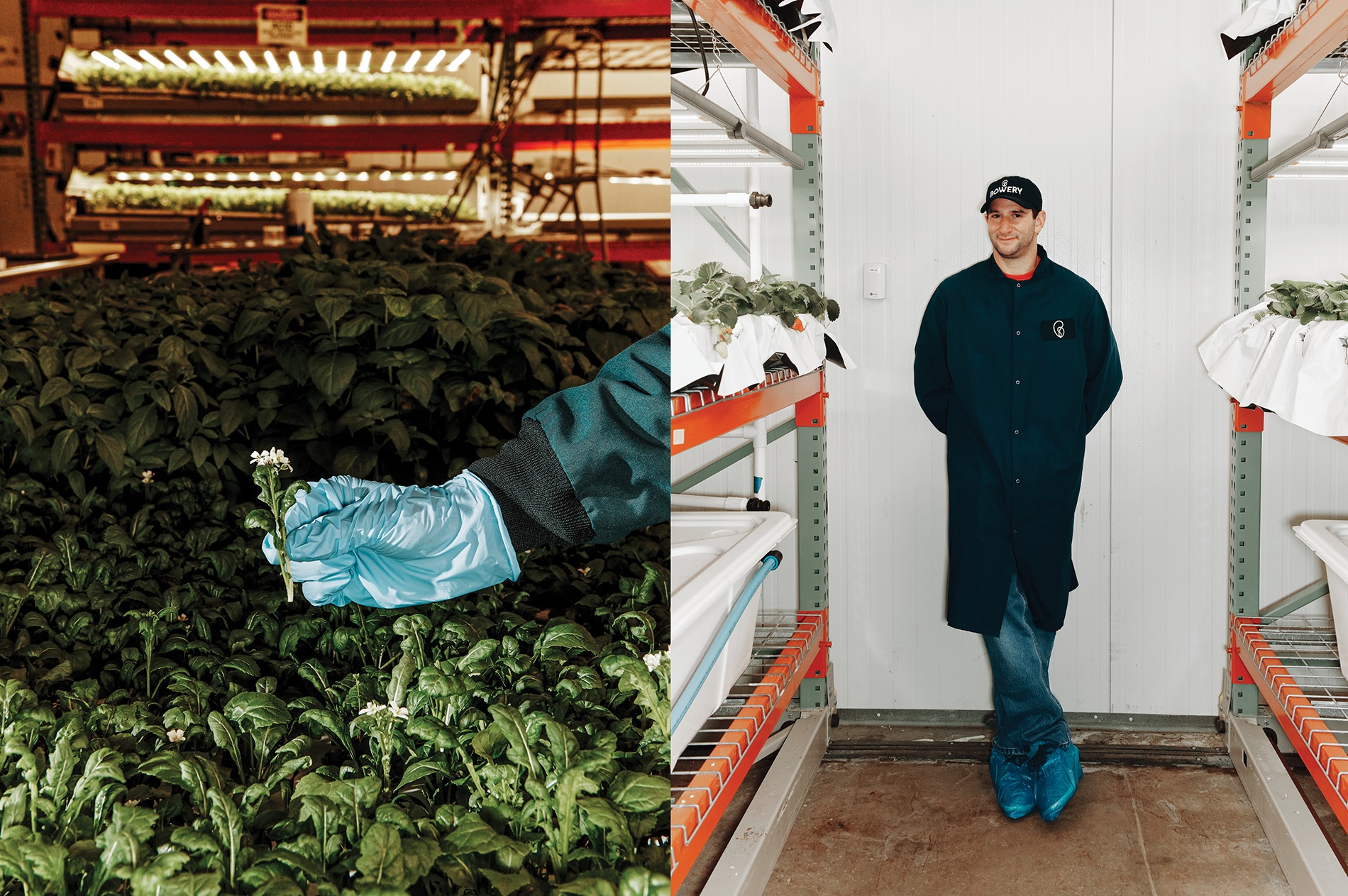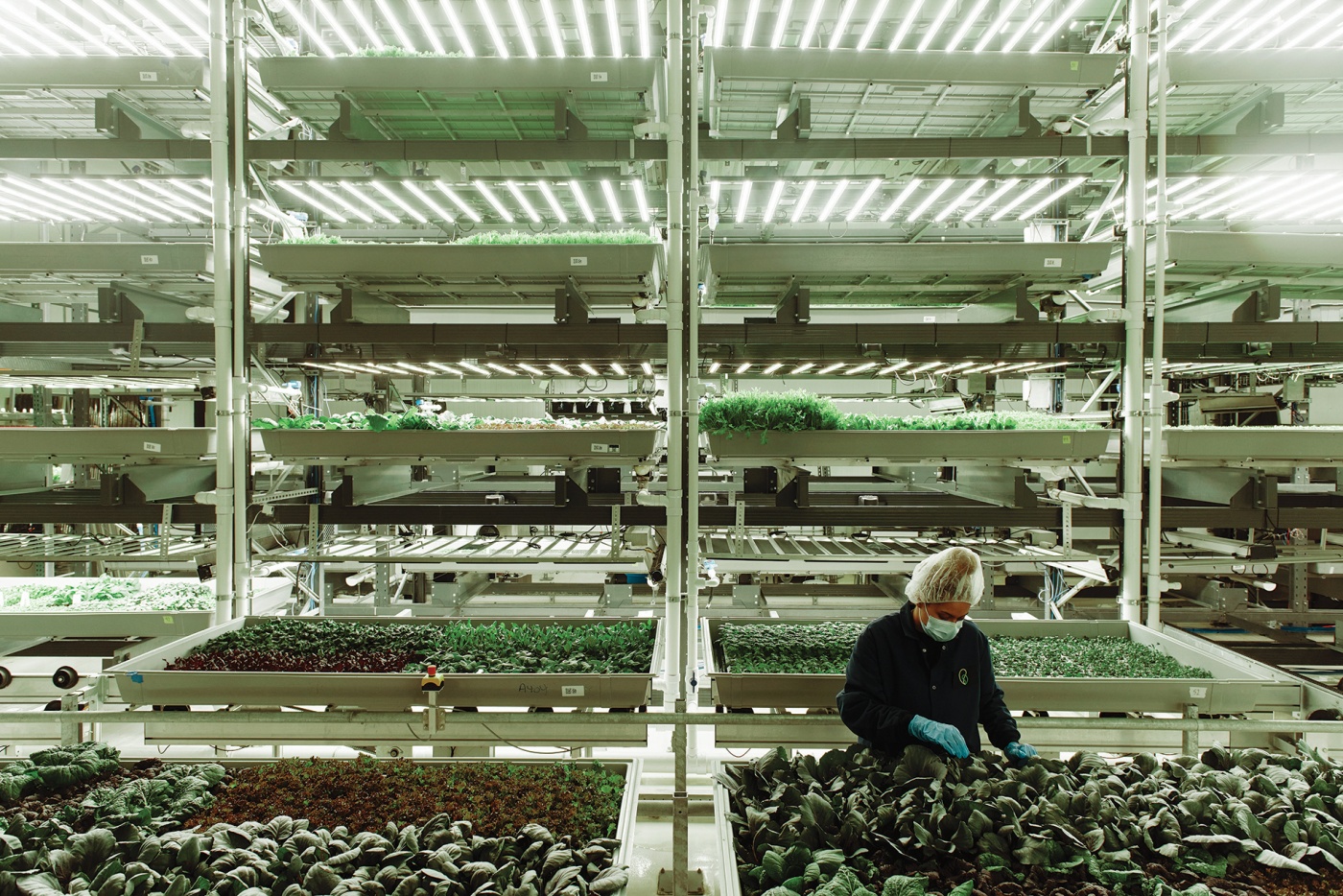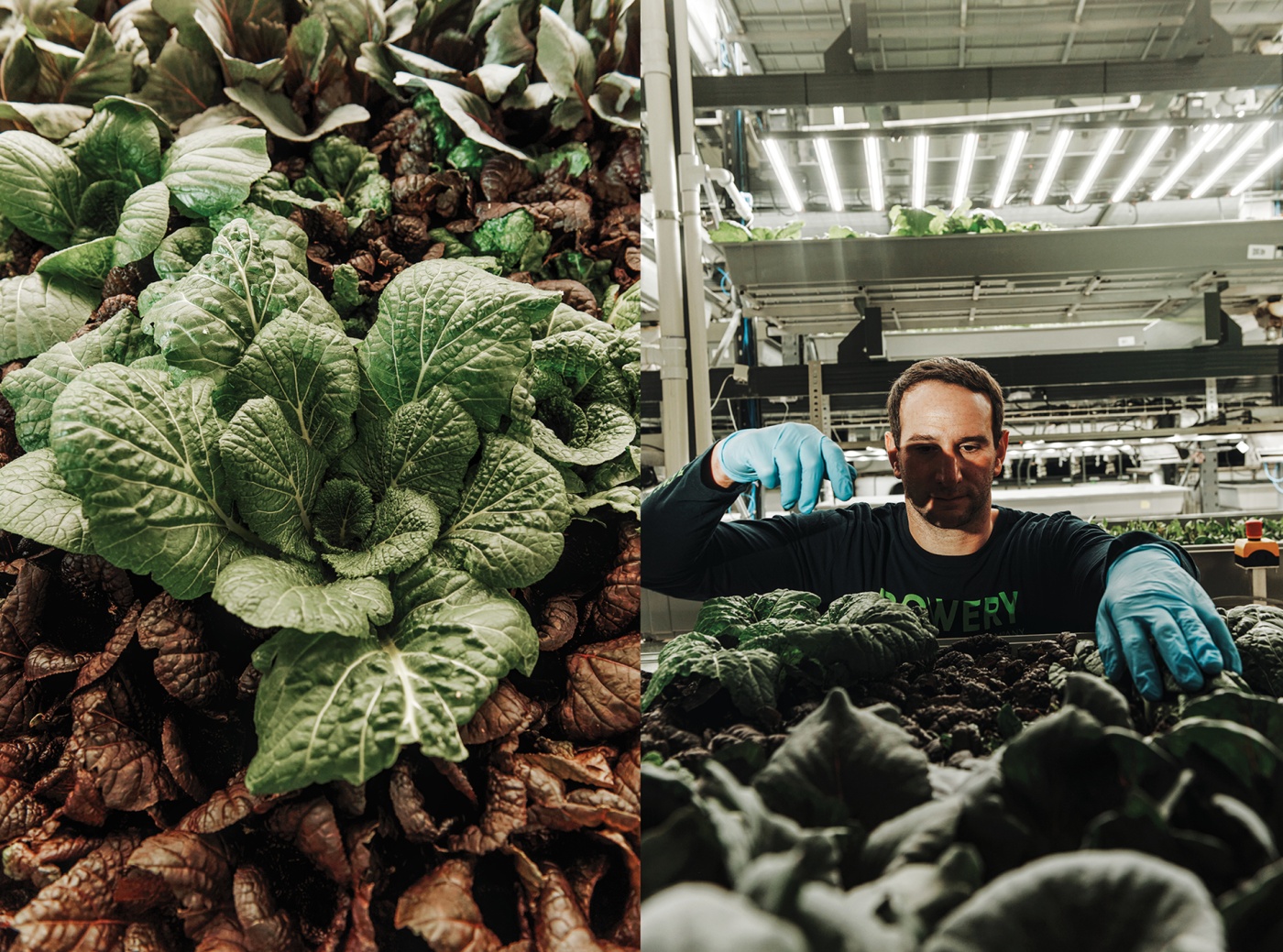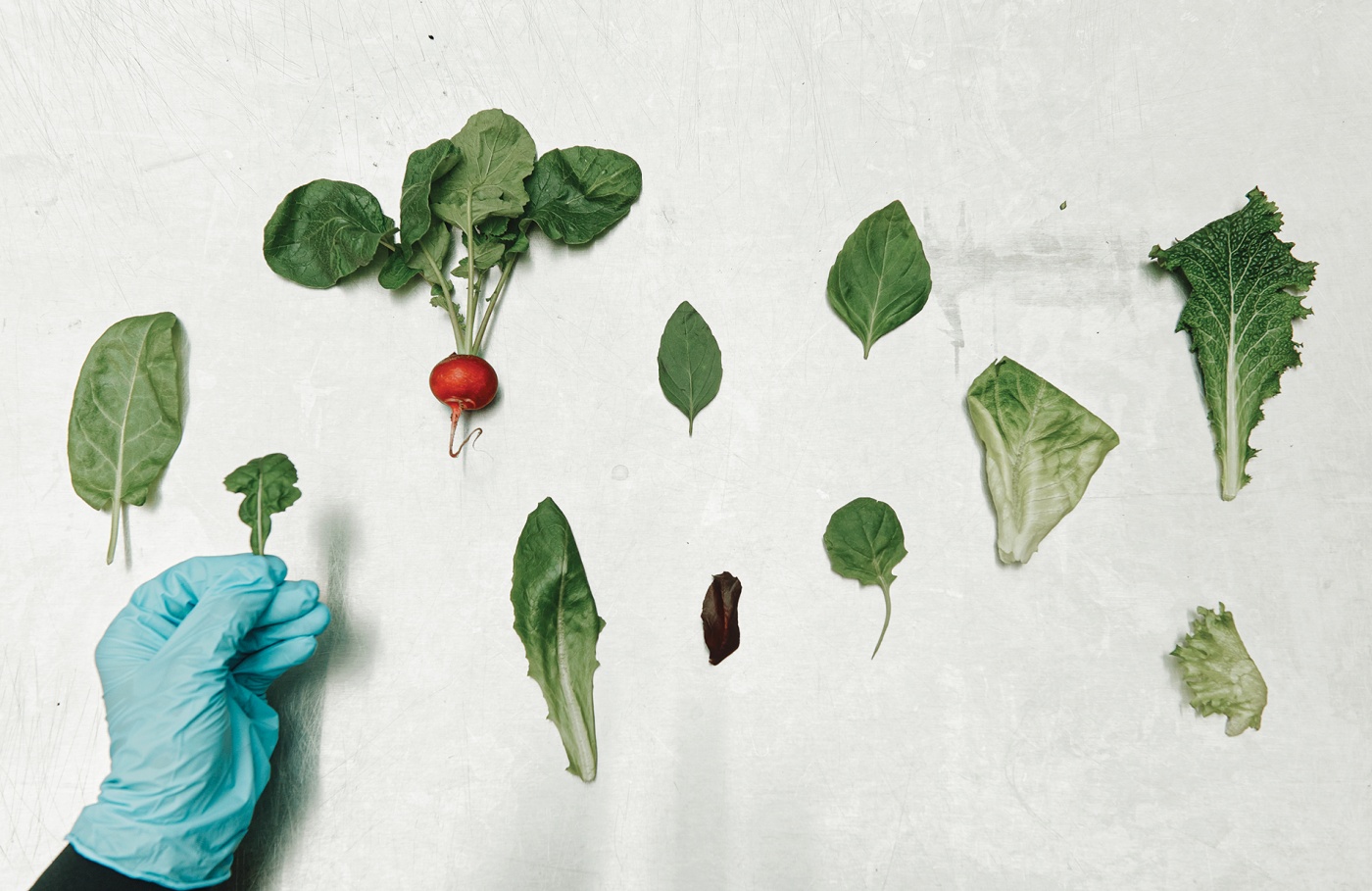
Cyber Farm
Irving Fain ’02 grows crops with less water, no pesticides, no dirt. Tended by algorithms and robots, pollinated by modified bees, and overseen by just a few humans in white suits, his vertical farms may be the answer to food security.
The farm of the future is tucked away in an unassuming warehouse in Jersey City, one of hundreds that line the Hudson River opposite New York City’s financial district. The heart of one of the world’s busiest seaports on the edge of the most populous city in the U.S. is an unlikely birthplace for agricultural revolution. But Bowery is not your typical farm and its CEO, Irving Fain ’02, is not your typical farmer.
Fain founded Bowery—an anglicization of the Dutch word for “farm”—in 2015 with a vision ambitious even by the lofty standards of today’s tech founders. He wanted to reshape global agriculture by infusing the world’s oldest industry with artificial intelligence, robotics, and other advanced technologies to deliver ultra-fresh, locally grown produce to the swelling ranks of urban dwellers. The idea was to bring farming indoors, where all the variables that affect plant growth—lighting, temperature, nutrients, water—can be precisely controlled.
This concept—technically referred to as “controlled-environment agriculture” but better known as vertical farming—is essentially the art and science of enhancing the production of traditional crops by turning the whole operation into an agricultural computer. Bowery’s vertical farms consist of a warehouse full of floor-to-ceiling shelves packed with trays of produce in various stages of the growing cycle. Every shelf is outfitted with sensors that monitor plant growth around the clock and use the resulting firehose of data to optimize growing conditions for each individual plant. Key variables—light intensity, airflow, temperature, nutrients, and humidity—are monitored and adjusted to create a cornucopia of produce that is tastier, more nutritious, and more environmentally benign than crops grown outdoors. But Bowery’s mission is about much more than bringing flavorful and aesthetically flawless produce to local markets. “We’re reimagining the entire fresh food supply chain to make it simpler, safer, and much more sustainable,” says Fain.
If Fain is right, the future of our species and our planet may depend on our ability to master large-scale vertical farming. The technologies and processes pioneered at Bowery have the potential to collapse global agricultural supply chains into regional networks that reduce the agricultural sector’s water consumption and rampant pesticide use without sacrificing yield. With Bowery, Fain aims to do nothing less than wrest control of global agricultural production from the tyrannical grip of Mother Nature herself.

The businessman farmer
Fain is the first to admit he’s an unlikely leader of an agricultural revolution. The gregarious 42-year-old usually carries himself with the laid-back attitude of a surfer—Fain has, in fact, been catching waves since he was a teenager—but when the conversation turns to agriculture, his casual veneer falls away. He’s deadly serious about the future of vertical farming and seems to want to tell you about its many benefits all at once. His mouth has trouble keeping up with the speed of his thoughts as he talks arugula and radishes with a zeal typically reserved for megachurch pastors. It’s clear he was born to do this. But until a few years ago, even he would have laughed if you had told him his destiny was to become a farmer.
Fain grew up in Providence, just up the street from Brown’s campus. He likes to say he wanted to be an entrepreneur long before he knew how to spell it. As a child, Fain and his younger brother were always on the lookout for ways to make a buck. There were lawn mowing businesses in the summer and snow shoveling services in the winter. As Fain entered his pre-teen years, he expanded his business empire to Brown, where he sold roses and T-shirts to students on campus.
Even at a young age, Fain’s knack for scaling his ventures was apparent. When his connection with a local florist dried up, Fain convinced his parents to take him to a wholesaler to buy roses in bulk. Another time, he struck up a joint venture with a Brown student selling T-shirts on campus and was so successful that the student sold the adolescent Fain his T-shirt business when he graduated. When it came time for Fain to choose a college, he knew only two things: He wanted to study business and he wanted to get as far away from his hometown as he could. But after surveying business schools around the country, he realized that Brown had everything he was looking for.
“I was really attracted to the freedom and openness Brown offered,” Fain says. “Being able to carve your own path and make your own way appealed to my entrepreneurial spirit. It’s really hard to find that in other places.”
He planned on pursuing an economics degree, but, after taking two introductory courses, realized he found the subject dull and not particularly useful for learning how to build a business. He decided to pursue an English degree and added some business-focused electives, including Barrett Hazeltine’s famed Engin 9/90 courses on management and entrepreneurship.
“Barrett is just iconic,” says Fain. “He was the first person I can think of at Brown who was really talking about entrepreneurship and creation in the way we think about it today.”
The skeleton crew of farmers clad in full-body clean suits moved like phantoms between the shelves, checking the status of their crops.
When Fain graduated with an English degree in 2002 the dust was just settling from the dot com crash, so he found his first foothold at an investment bank working on a team responsible for raising capital for early-stage startups. Here he was exposed to the world of venture finance and what it looks like to build a company from the ground up.
After a few years Fain took a break and traveled the world. Another venture capital firm followed before he landed at broadcast giant Clear Channel, where he helped build what would eventually become iHeartRadio, now the largest radio broadcaster in the U.S.
Despite these early successes, he felt restless. He wanted to build businesses, not finance them. He and Clear Channel colleague Josh Bowen hit on an idea for a loyalty and analytics platform they called CrowdTwist. A massive success, it was acquired by Oracle in 2019—but it wasn’t what Fain wanted to spend the rest of his life doing. He began trying to identify industries with the potential for serious impact. After landing on agriculture, he considered a variety of angles, from self-driving tractors to satellite imagery, before focusing on vertical farming.
For Fain, vertical farming was an obvious solution to most of global agriculture’s big problems. It’s easy on water supplies, a standout in an industry that currently uses 70 percent of the world’s fresh water. It wouldn’t use any of the roughly 6 billion pounds of pesticides deployed by farmers each year. It wouldn’t contribute to the destruction of arable farmland, which has declined by 30 percent since 1980. And it would shrink agriculture’s carbon footprint by enabling any type of produce to be grown locally anywhere in the world.
There was one glaring problem: No one had managed to make all the technologies work profitably at scale.
Robots and radishes
I visited Bowery’s HQ in early November, a time when most farmers around the United States are wrapping up their annual harvest. But as Fain explained, it’s always peak growing season at Bowery. “We can build a farm in any city anywhere and create the exact climate that we want,” Fain told me. “We’re democratizing access to high-quality fresh produce.”
The New Jersey facility consists of three vertical farms: the original pilot farm and a scaled-up version, both of which serve grocers in the tri-state area, plus a relatively new facility called Farm X that functions as an R&D lab. Now the largest vertical farming company in the world, the company has two new farms beginning service on the East Coast and more planned for Georgia and Texas. It supplies Walmart, Whole Foods, and New York bodegas.

By stacking plants on top of each other, Bowery is able to grow far more produce per square foot than a conventional farm. Bright white LED lights hang on each shelf, providing full-spectrum lighting to the beds below in an artificial day-night cycle that is fine-tuned to the life-
cycle stage of the plants. On the wall, flat-screen TVs cycle through live video feeds from hundreds of cameras throughout the farm. This produce panopticon plays a critical role in Bowery’s operations by supplying the data to the company’s proprietary machine vision system that automatically detects when a given plant isn’t growing as expected.
Each growing shelf is connected to a robotic assembly line that can deliver new trays of freshly planted seeds and fetch trays of mature plants for harvest. Both the planting and harvesting processes are fully automated using custom machinery built specifically by Bowery. The end-to-end automation minimizes human input and means that just a handful of technicians—Fain calls them farmers—can manage all the processes it takes to feed thousands of consumers.
“The farmers are always going to be an important part of the equation,” says Fain. “It’s a question of how people and machines can work well with one another to be more efficient and achieve a better outcome.”
The skeleton crew of farmers clad in white full-body clean suits moved like phantoms between the shelves, checking the status of their crops. It’s a hydroponic farm—each seed is planted in a growth medium and fed with nutrient-rich water that flows over its roots. This eliminates the need for soil or pesticides, limits water use, and allows Bowery to precisely tune nutrient delivery.
Fain avoids describing Bowery’s produce as organic because it is grown under more stringent standards than the U.S. Department of Agriculture certified organic produce that is found in stores today. Whereas some 70 percent of produce contains traces of pesticides, Bowery’s crops contain no pesticides at all and are always grown from seeds that are not genetically modified. “We could be labeled organic if we wanted to, but we don’t focus on being organic because we have a product that’s even better,” says Fain. “Organic is a good step forward for the industrial agricultural system, but we are completely chemical free, we’re using a fraction of the resources, and it’s also a much fresher product.”
The robotics, lighting, and endless shelves make Bowery feel like something ripped straight from a pulp science fiction novel. In many respects, its vertical farms look more like a surgical operating theater or a cleanroom for assembling spacecraft than agriculture. This is by design. The farms are optimized for control, which means limiting unexpected inputs like pests or difficult-to-control variables like natural sunlight.
Fain aims to do nothing less than wrest control of global agricultural production from the tyrannical grip of Mother Nature herself.
“Your ability to change these variables at a mass scale in real time is essentially impossible outside,” says Fain. “All of these externalities that are uncontrollable in traditional farming are completely controllable in vertical farming.”
The farm’s nervous system is called the Bowery Operating System, a software platform built to manage every aspect of operations from the time a seed is planted until the produce is delivered to a grocery store. Bowery OS ingests millions of data points from thousands of sensors throughout each of the company’s farms and combines this information—which includes temperature readings, images, water flow rates, and luminosity—to get a comprehensive picture of growing conditions. Then it adjusts them based on predictions made by its machine learning algorithms.
It’s this last part that makes Bowery’s farms a true agricultural revolution. By feeding data on every individual plant across its entire lifecycle to an AI, Bowery’s farms get smarter with each harvest. Every new farm will have access to the data created by every farm before it. While traditional farmers were limited in their ability to learn from past harvests by the number of environmental factors beyond their control, Bowery has created an internet of farms that are constantly improving themselves.
A better berry
Today, most of the produce rolling out of Bowery’s farms are romaine, arugula, and kale. Fain says the choice to start with leafy greens was an economically pragmatic one. When you grow lettuce, most of the plant mass is saleable, unlike fruits and vegetables that might be only a small part of a larger plant.
But Fain sees leafy greens as just the beginning. The company has already grown hundreds of other crops such as strawberries, tomatoes, peppers, onions, carrots, radishes, and more exotic fare such as wasabi arugula and green sorrel. Farm X launched in 2021, housing a team of agricultural scientists focused on identifying new varieties of common produce and selectively breeding plants to express desired traits.
When I visited Farm X in November, the main hall of the facility was indistinguishable from a chemistry lab, with microscopes and all manner of scientific instruments arranged around a long table where scientists sat studying—and tasting—strawberries fresh from an experimental grow room down the hall.

Those grow rooms are each about the size of a shipping container and look like scaled-down versions of Bowery’s commercial farms. Inside the strawberry room, hundreds of squat strawberry bushes lined the shelves in various stages of fruiting. Unlike many of Bowery’s commercial products, strawberries require a pollinator—so Bowery’s scientists outfitted the grow room with several artificial beehives and populated them with stinger-less bees. The presence of these insect pollinators stands in sharp contrast to the otherwise entirely artificial environmental conditions in the rest of the farm, but as Fain points out, sometimes nature’s solution works best.
“Our view is, let’s apply technology in the right places at the right times,” says Fain. “If there’s a better way to do something, like using bees, then we’ll do that.”
Bowery works with seed banks around the world to find new varieties of common and exotic produce. And because of the way Farm X is set up, it can selectively breed these plants far more efficiently than any agricultural operation in the past. The result? The strawberries I tried on my visit were the most succulent berries I have ever tasted. It was hard to believe that they were even related to the relatively bland and stale strawberries found in most grocery stores.
“Berries are exciting because it’s a product that has so much flavor and vibrancy,” Fain told me as we sampled a variety of wild strawberry being studied by Bowery’s scientists. “But because of challenges like seasonality, growing, and transportation, the berries we get are not close to the berries that we deserve.”
The future of vertical farming
Until Fain founded Bowery, vertical farming was an idea ahead of its time. The genesis of the concept can be traced back to NASA in the early ’80s, which pioneered new ways for growing produce in controlled indoor environments to feed astronauts on long space missions. While these early forays into vertical farming worked, the technology needed to scale them into commercial enterprises just wasn’t ready—it was far too expensive compared to traditional agriculture.
The modern concept of vertical farming was first conceptualized by Dickson Despommier, a professor of microbiology and public health at Columbia University, about a decade ago. Despommier envisioned skyscrapers converted into massive indoor farms capable of feeding entire cities. He argued that vertical farming at scale was finally practical due to advances in AI, robotics, and agricultural science. Each of these technologies plays a crucial role, but Fain cited breakthroughs in LED production as the key technological development that made Bowery possible.
“When we look at climate change, we know bad things are going to happen. Growing indoors will become a big part of food security.”
Lighting is one of the biggest costs in running a vertical farm and is responsible for most of its energy usage. Over the past decade, the price of LEDs has dropped precipitously while the energy efficiency of those lights has skyrocketed. Haitz’s law, the LED equivalent of Moore’s law, observes that every decade the cost of LEDs drops by a factor of 10 while the amount of light they generate increases by a factor of 20. This suggests that LEDs will continue to get cheaper and more efficient for years into the future, further driving down the cost of vertical farming. At the same time, advances in renewable energy resources, particularly energy storage, mean vertical farms no longer need to rely on carbon-intensive coal or natural gas. Bowery, in fact, uses 100 percent renewable energy.
The confluence of technological developments has come just in time. The UN estimates food production will have to increase by 60 percent over the next 30 years to feed the world’s growing population. At the same time, urbanization shows no sign of slowing. Combined with the rapid loss of arable land due to unsustainable farming practices, the growing use of pesticides, and global supply chains vulnerable to natural disasters, it’s clear that business as usual will no longer suffice.
“We have enough food to feed 10 billion people, but there’s a problem of distribution,” says Dawn King, a senior lecturer in environment and society at Brown who is not affiliated with Bowery. “I see vertical farming as really contributing to regional food supply chains because they can be much more resilient than farming that depends on Mother Nature. When we look at climate change, we know bad things are going to happen. Growing indoors will become a big part of our food security.”
Like King, Fain takes issue with people who describe the food supply chain as “broken.” On the contrary, he views it as something of a modern marvel that accomplished exactly what it was meant to: delivering fresh produce anywhere on the globe regardless of the season. What has changed is the context. The global food supply chain is not sustainable, and while Fain doesn’t pretend that vertical farming is the silver bullet that will solve all our food woes, he does see it as a critical part of the solution.
“The agriculture system is enormous and the idea that vertical farming is the only answer is unrealistic,” says Fain. “But crops that are grown in a more sustainable, less resource-intensive way are going to be a much larger part of the overall agricultural system in years to come.”
Daniel Oberhaus is a science writer in Brooklyn and author of The Silicon Shrink, a forthcoming book about AI and psychiatry.





